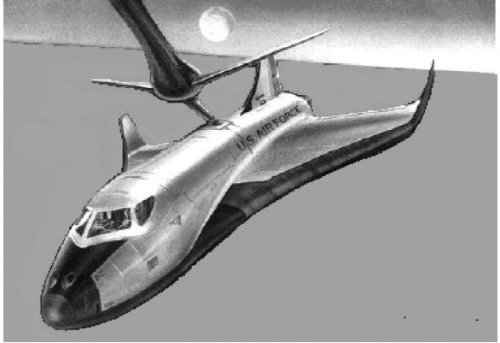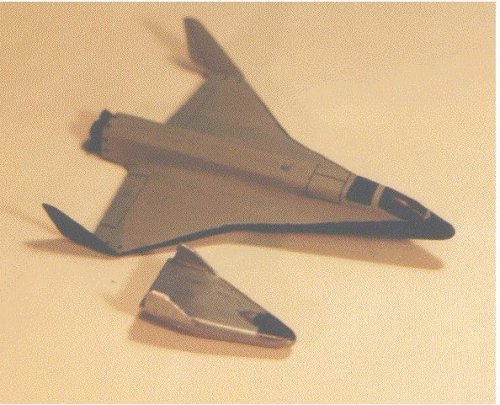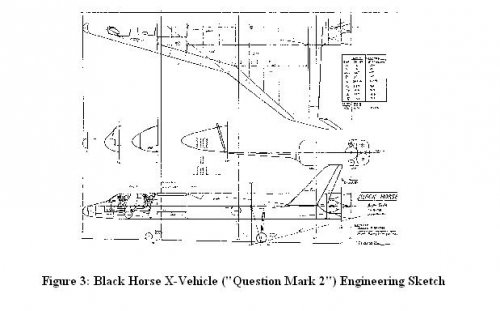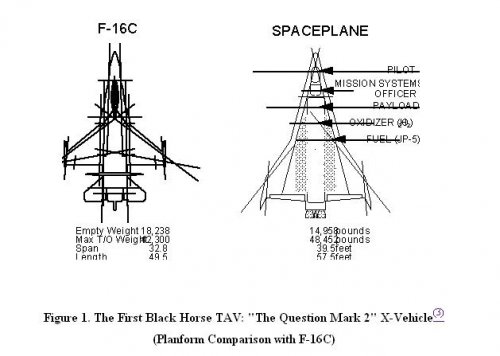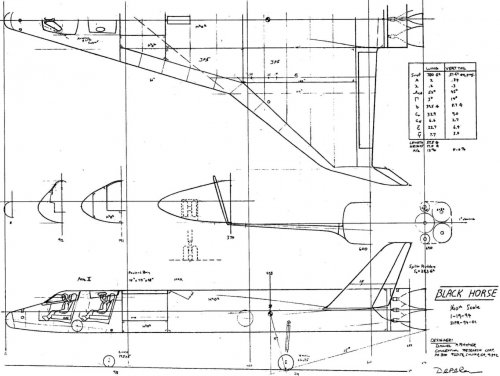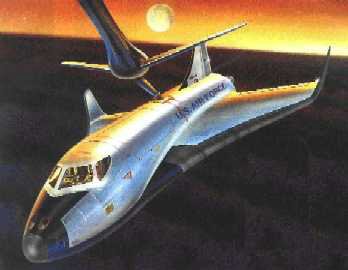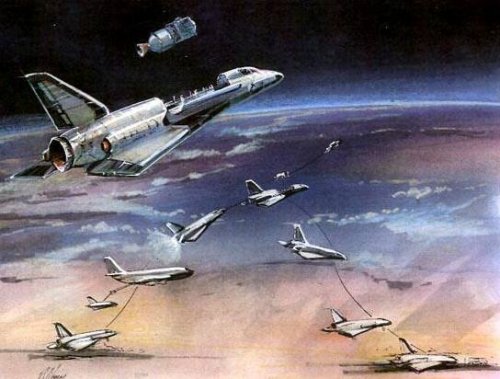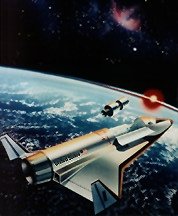You are using an out of date browser. It may not display this or other websites correctly.
You should upgrade or use an alternative browser.
You should upgrade or use an alternative browser.
Black Horse
- Thread starter hesham
- Start date
- Joined
- 13 August 2007
- Messages
- 8,454
- Reaction score
- 11,030
http://www.astronautix.com/lvs/blahorse.htm
http://www.airpower.maxwell.af.mil/airchronicles/apj/apj95/sum95_files/spacast3.htm
http://www.aircraftdesign.com/blackhorse_3view.jpg
http://www.aircraftdesign.com/blackhorse_painting.jpg
the Idea is not bad
a rocket plane that use JP-5 and H2O2
after liftoff from Air base Refuel by KC-135
launch into low earth orbit
there allot dispute about the Black Horse study
have they build it and use it as top secret Reconnaissance ?
http://www.airpower.maxwell.af.mil/airchronicles/apj/apj95/sum95_files/spacast3.htm
http://www.aircraftdesign.com/blackhorse_3view.jpg
http://www.aircraftdesign.com/blackhorse_painting.jpg
the Idea is not bad
a rocket plane that use JP-5 and H2O2
after liftoff from Air base Refuel by KC-135
launch into low earth orbit
there allot dispute about the Black Horse study
have they build it and use it as top secret Reconnaissance ?
hesham said:Hi,
http://www.islandone.org/Launch/Blackhorse-bhm2f2.gif
Ah, the good old days... these were two of the first model kits I ever released...
Michel Van said:the Idea is not bad
a rocket plane that use JP-5 and H2O2
after liftoff from Air base Refuel by KC-135
launch into low earth orbit
there allot dispute about the Black Horse study
have they build it and use it as top secret Reconnaissance ?
The idea isn't very sound, in my estimation. The wings and cruise engines (or rockets) have to be sized for supporting the full mass of the spaceplane just after tanking. The only mass savings from airborne propellant transfer comes in the form of lighter landing gear, sized for supporting the craft without its load of oxidizer.
There are some advantages to this approach that are shared with air-launch: optimization of the nozzle for operating in the thinner upper atmosphere, mission flexibility, and reduced drag losses. With that being said, I don't think any of these add up to being able to pull off single-stage-to-orbit flight.
Given the higher structural mass of winged spacecraft relative to ballistic rockets, it's hard to see airborne propellant transfer as an enabling technology for SSTO. The value of APT is increasing the payload of a viable TSTO system.
CFE said:The wings and cruise engines (or rockets) have to be sized for supporting the full mass of the spaceplane just after tanking. The only mass savings from airborne propellant transfer comes in the form of lighter landing gear, sized for supporting the craft without its load of oxidizer.
You also get lighter wings (and associated TPS and such). Wings that only get hit with the full weight of the propellant when the vehicle is already going 400 knots can be much smaller than those that need to lift the fully-loaded vehicle off the runway at less than 150 knots.
Don't think inflight refuelling will make SSTO viable.
What is really interesting is having an upper stage in the bay. Black Horse led to Black Colt, then to the RocketPlane Pathfinder. The last two sounds more interesting...
Tell me if I'm wrong somewhere
Black Horse
- no turbofans
- SSTO
- H2O2 + Kerosene
Black Colt
- turbofans (more practical when refuelling...but too heavy for a SSTO)
- sub-orbital
- upper stage send payload to orbit
RocketPlane Pathfinder
- turbofans
- suborbital
- drop H2O2 in favour of an off-the-shelf RD-120 from Russia, because the project is now a private venture.
Problem: LOX in much more difficult to transfer than H2O2 (non cryogenic)
IMHO the Black Colt sounded the most interesting design of the three...
What is really interesting is having an upper stage in the bay. Black Horse led to Black Colt, then to the RocketPlane Pathfinder. The last two sounds more interesting...
Tell me if I'm wrong somewhere
Black Horse
- no turbofans
- SSTO
- H2O2 + Kerosene
Black Colt
- turbofans (more practical when refuelling...but too heavy for a SSTO)
- sub-orbital
- upper stage send payload to orbit
RocketPlane Pathfinder
- turbofans
- suborbital
- drop H2O2 in favour of an off-the-shelf RD-120 from Russia, because the project is now a private venture.
Problem: LOX in much more difficult to transfer than H2O2 (non cryogenic)
IMHO the Black Colt sounded the most interesting design of the three...
Archibald said:Don't think inflight refuelling will make SSTO viable.
The math on Black Horse consistantly worked. It was perhaps in a somewhat limited performance/propellant envelope... the reason why H2O2 was chosen rather than O2 was that the ratio of H2O2/fuel was far higher than it'd be for LOX/fue, meaning that the benefit of inflight ox loading would be that much greater for H2O2.
Kevin Renner
ACCESS: Confidential
- Joined
- 6 November 2007
- Messages
- 102
- Reaction score
- 12
Something like Black Horse isn't really a SSTO. True the vehicle would go up as one stage and come back as one but in reality it is a Two Stage Vehicle in which the first stage is really the tanker A/C. The two stages just don't leave the ground together.
- Joined
- 1 April 2006
- Messages
- 11,397
- Reaction score
- 10,314
Kevin Renner
ACCESS: Confidential
- Joined
- 6 November 2007
- Messages
- 102
- Reaction score
- 12
While I admit not being an aeronaticual engineer I always thought one way to packeage the engines for a BH type vehicle would be to have reasonably sized turbofan have its airflow pass arounda pod or bullet extension holding the rocket motor
information about the blackhorse spaceplane:
http://www.islandone.org/Launch/BlackHorse.html
http://www.islandone.org/Launch/BlackHorse-PropTransfer.html
overview:
http://www.islandone.org/Launch/
and last but not least:
http://www.risacher.org/bh/
http://www.islandone.org/Launch/BlackHorse.html
http://www.islandone.org/Launch/BlackHorse-PropTransfer.html
overview:
http://www.islandone.org/Launch/
and last but not least:
http://www.risacher.org/bh/
- Joined
- 18 March 2008
- Messages
- 3,529
- Reaction score
- 983
Re: Black Horse copyright
You can't copyright a name, unless its a very long one. A quick search of ATMOS, the Australian Trade Mark register, shows "Black Horse" is registered trade mark of Lloyds Bank Plc of London... The USTPO's TESS shows some 47 tradmarks, live and dead, to do with Black Horse. You are not allowed to have competing marks in the same product range. So its OK to have Black Horse (TM) Power Boats and Black Horse (TM) Golf Carts.
http://tess2.uspto.gov/bin/showfield?f=toc&state=4003%3A3i6vd4.1.1&p_search=searchss&p_L=50&BackReference=&p_plural=yes&p_s_PARA1=&p_tagrepl~%3A=PARA1%24LD&expr=PARA1+AND+PARA2&p_s_PARA2=black+horse&p_tagrepl~%3A=PARA2%24COMB&p_op_ALL=AND&a_default=search&a_search=Submit+Query&a_search=Submit+Query
FlyBack said:Does anyone know if the name "Black Horse" is copyrighted or a registered trademark.
You can't copyright a name, unless its a very long one. A quick search of ATMOS, the Australian Trade Mark register, shows "Black Horse" is registered trade mark of Lloyds Bank Plc of London... The USTPO's TESS shows some 47 tradmarks, live and dead, to do with Black Horse. You are not allowed to have competing marks in the same product range. So its OK to have Black Horse (TM) Power Boats and Black Horse (TM) Golf Carts.
http://tess2.uspto.gov/bin/showfield?f=toc&state=4003%3A3i6vd4.1.1&p_search=searchss&p_L=50&BackReference=&p_plural=yes&p_s_PARA1=&p_tagrepl~%3A=PARA1%24LD&expr=PARA1+AND+PARA2&p_s_PARA2=black+horse&p_tagrepl~%3A=PARA2%24COMB&p_op_ALL=AND&a_default=search&a_search=Submit+Query&a_search=Submit+Query
FutureSpaceTourist
ACCESS: Top Secret
- Joined
- 10 March 2010
- Messages
- 590
- Reaction score
- 34
There's a fair amount of Black Horse material at http://www.ai.mit.edu/projects/im/magnus/bh/
- Joined
- 26 May 2006
- Messages
- 34,913
- Reaction score
- 15,789
Attachments
XP67_Moonbat
ACCESS: Top Secret
- Joined
- 16 January 2008
- Messages
- 2,271
- Reaction score
- 544
I always wondered what happened to that concept.
martinbayer
ACCESS: Top Secret
- Joined
- 6 January 2009
- Messages
- 3,398
- Reaction score
- 3,907
XP67_Moonbat said:I always wondered what happened to that concept.
The same that has happened to all other RLV concepts to date - nothing...
Martin
- Joined
- 26 September 2008
- Messages
- 1,960
- Reaction score
- 746
martinbayer said:The same that has happened to all other RLV concepts to date - nothing...
I remain skeptical that SpaceX is going to make reusability work. Even if they can make it work technically, the economics may be marginal and it may not succeed. And certainly there has been a tremendous amount of hype over what they are doing, with many fanboys already declaring success and designing their own space programs based upon cost savings that they pull out of thin air, or a monkey's butt.
That said, I think there is an important distinction between what SpaceX is doing now and the previous RLV concepts and it is that a lot of them required some big leaps with no intermediary steps and no way to gradually move towards reusability. Everything just had to be designed, and then work right. With SpaceX, they're actually doing testing with vehicles that are otherwise operational. So the testing is just a bonus, and if the test does not succeed, they're still okay. And in fact, even if they don't get their reusable first stage to work economically, they are still left with an economical throwaway rocket. So they get something out of it. The same is not true of Black Horse or the other earlier proposals. If they didn't work technically, you were screwed, and if they didn't work economically, you were also screwed.
blackstar said:I remain skeptical that SpaceX is going to make reusability work. Even if they can make it work technically, the economics may be marginal and it may not succeed.
The reliability to weight ratio has always been so close that it seems near impossible that they could even find optimizations in re-usability. I would imagine there would be more room for cost savings improvement in mass production.
- Joined
- 26 September 2008
- Messages
- 1,960
- Reaction score
- 746
sublight is back said:The reliability to weight ratio has always been so close that it seems near impossible that they could even find optimizations in re-usability. I would imagine there would be more room for cost savings improvement in mass production.
The problem is that you have to have a demand for a lot of rockets. So mass production may not work either.
XP67_Moonbat said:I always wondered what happened to that concept.
It become rocketplane XP, and later merged with Kistler - and sunk the company with an unworkable subrobital Learjet (the XP)
Mitchell Burnside Clapp currently work at DARPA.
- Joined
- 2 May 2007
- Messages
- 497
- Reaction score
- 1,963
Found this mov file on my hard drive, then realised it's still available on The Black Horse Page
A QuickTime movie (1.2Mb) created by Sabri Sansoy
A QuickTime movie (1.2Mb) created by Sabri Sansoy
Ah, the Black Horse Page. Still wrong after *30* years...Found this mov file on my hard drive, then realised it's still available on The Black Horse Page
These images are from a student at Indiana State University who builds models. His email is <selowthe@iastate.edu>. He had these pictures on his WWW page of his model of the Black Horse. (redistributed with permission)



Indiana? INDIANA?!?!
I remain skeptical that SpaceX is going to make re-usability work.
Still skeptical??
I know you are joking, second degree. A little humourous provocation.I remain skeptical that SpaceX is going to make re-usability work.
Still skeptical??
But that was in 2015, for crap sake. SpaceX technical and business present success wasn't obvious by any mean.
Closest thing was Kistler 's K-1, which actually got one of the COTS contracts besides SpaceX, in 2006. Only to lose to OSC Cygnus in 2007. Kistler management sucked immensely and doomed them.
Before 2016 there was a lot of scepticism related to flyback boosters at different levels
- economics: what kind of flight rate, and was it achievable ?
- technically: the return to launch site issue was a giant PITA.
a) Kistler would not solve it: downrange landings on airbags, return to launch site on trucks or choppers or aircraft
b) NASA tried a lot but never solved it properly either (Shuttle II, Space Shuttle flyback boosters - tons and tons of paper studies)
c) the Russian Baikal (Le Bourget 2001 had a mockup) applied cruise missile technology and autoland to try and return smaller boosters.
d) Also Buzz Aldrin & Hu Davis Starbooster
e) Arianespace & Shuttle SRB recovery at sea was not encouraging at all, as far as flight rates were concerned.
Crucially, the peculiar way SpaceX pulled it in 2015-2016 was rarely studied before. I mean, landing a Saturn S-IB size booster like an helicopter on tamed rocket power, under control of computer ? Seemed a bit dubious.
I asked the question a few years ago. https://forum.nasaspaceflight.com/index.php?topic=45031.0 A very interesting question from the good old days... (sigh)
Last edited:
Rhinocrates
ACCESS: Top Secret
- Joined
- 26 September 2006
- Messages
- 3,054
- Reaction score
- 7,787
I believe Scott has some first hand experience of the Black Horse project and can enlighten us unless there is an NDA involved.
I believe Scott has some first hand experience of the Black Horse project and can enlighten us unless there is an NDA involved.
He mostly had first experience of Bob Zubrin in the process and, well, it wasn't a happy experience, or so it seems.
(yes, Zubrin joined Clapp in 1996 at Pioneer).
Black Horse had passed on by the time Pioneer Rocketplane started. BH was pure rocket, while Pioneer had two turbojets; BH was SSTO, while Pioneer was very definitely TSTO.I believe Scott has some first hand experience of the Black Horse project and can enlighten us unless there is an NDA involved.
The idea had merit and almost certainly could have been made to work. Whether it coudl have competed with SpaceX is perhaps now dubious, but in the mid 90's the idea of a long, thin, conventional rocket stage landing itself with a hoverslam maneuver seemed kinda far fetched. It doubtless would have been capable of carrying out many more missions than Falcon (one that seemed oddly feasible was using the vehicle, sans upper stage, as a hypersonic transport for fresh *fish* to Japan), but scaling it up in size would have been much more difficult than for Falcon-like rockets.
"it wasn't a happy experience"and what does that means ?
The right leader can take a fragiletiny company and turn it into a behemoth, striding across the landscape fulfilling all of the core ideas potential, and more
The wrong leader...
- Joined
- 2 May 2007
- Messages
- 497
- Reaction score
- 1,963
Ah, I thought that was your Hoosier doppelganger Erasmus SelowthThese images are from a student at Indiana State University who builds models. His email is <selowthe@iastate.edu>. He had these pictures on his WWW page of his model of the Black Horse. (redistributed with permission)
Last edited:
Black Horse had passed on by the time Pioneer Rocketplane started. BH was pure rocket, while Pioneer had two turbojets; BH was SSTO, while Pioneer was very definitely TSTO.I believe Scott has some first hand experience of the Black Horse project and can enlighten us unless there is an NDA involved.
The idea had merit and almost certainly could have been made to work. Whether it coudl have competed with SpaceX is perhaps now dubious, but in the mid 90's the idea of a long, thin, conventional rocket stage landing itself with a hoverslam maneuver seemed kinda far fetched. It doubtless would have been capable of carrying out many more missions than Falcon (one that seemed oddly feasible was using the vehicle, sans upper stage, as a hypersonic transport for fresh *fish* to Japan), but scaling it up in size would have been much more difficult than for Falcon-like rockets.
Going all-out FLOCK with 4 or 8 vehicles doing suborbital docking or refueling could crush SpaceX Starship into submission.
Dear John Goff had a fun take at it.
Going all-out FLOCK with 4 or 8 vehicles doing suborbital docking or refueling could crush SpaceX Starship into submission.
Only through laughter. A system like that would be a logistical nightmare and operationally incredibly complex.
- Joined
- 12 November 2021
- Messages
- 43
- Reaction score
- 88
Black Horse: One Stop to Orbit. Robert Zubrin, Mitchell Clapp
AIAA 94-2923
An Examination of the Feasibility of Winged SSTO Vehicles Utilizing Aerial Propellant Transfer
Robert M. Zubrin
Martin Marietta Astronautics Denver, Colorado
and
Capt. Mitchell B. Clapp Phillips Laboratory Kirtland AFB, New Mexico
AIAA 94-2923
An Examination of the Feasibility of Winged SSTO Vehicles Utilizing Aerial Propellant Transfer
Robert M. Zubrin
Martin Marietta Astronautics Denver, Colorado
and
Capt. Mitchell B. Clapp Phillips Laboratory Kirtland AFB, New Mexico
Similar threads
-
-
-
New RAND Release - Crisis Stability and Long Range Strike
- Started by bobbymike
- Replies: 2
-
Rand Report on Future "Swing Force" Part COIN part Conventional Ops
- Started by bobbymike
- Replies: 0
-

